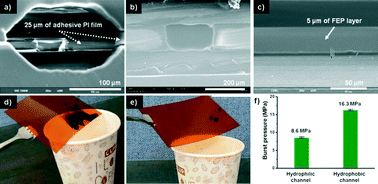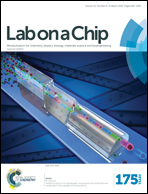Multilayered film microreactors fabricated by a one-step thermal bonding technique with high reproducibility and their applications†
Abstract
We report the versatile uses of multilayered polyimide (PI) film microreactors with various functions including pressure tolerance, three-dimensional mixing and multistep membrane emulsification. Such PI film microreactors were fabricated by a simple one-step thermal bonding technique with high reproducibility. Upon bonding at 300 °C for 1 hour, the thin and flexible film microdevices could withstand pressure up to 8.6 MPa and 16.3 MPa with PI adhesive film or fluoropolymer adhesive, respectively, due to differences in wettability. The hydrophilic and hydrophobic microchannel devices were used to generate monodisperse oil-in-water (O/W) and water-in-oil (W/O) droplets, and polymer micro/nanoparticles at a high generation frequency. A monolithic and chemical resistant film microreactor with a three-dimensional serpentine microchannel was used for the selective reduction of ester to aldehyde by efficient mixing and quenching in a flash chemistry manner, within a several 101 millisecond time scale. Furthermore, a novel multilayered film microreactor for organic–aqueous biphasic interfacial reactions was devised by embedding a membrane layer to induce chaotic mixing in both the interface and emulsified phase by flowing through multiple numbers of meshed structures along the hydrophobic channel. This simple and economic fabrication technique significantly facilitates mass production of multilayered film devices that could be useful as a platform for various microfluidic applications in chemistry and biology.


 Please wait while we load your content...
Please wait while we load your content...